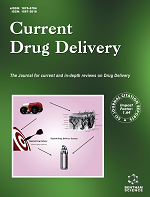- Home
- A-Z Publications
- Current Drug Delivery
- Previous Issues
- Volume 16, Issue 3, 2019
Current Drug Delivery - Volume 16, Issue 3, 2019
Volume 16, Issue 3, 2019
-
-
Delivery of Dry Powders to the Lungs: Influence of Particle Attributes from a Biological and Technological Point of View
More LessAuthors: Sarah Zellnitz, Eva Roblegg, Joana Pinto and Eleonore FröhlichDry powder inhalers are medical devices used to deliver powder formulations of active pharmaceutical ingredients via oral inhalation to the lungs. Drug particles, from a biological perspective, should reach the targeted site, dissolve and permeate through the epithelial cell layer in order to deliver a therapeutic effect. However, drug particle attributes that lead to a biological activity are not always consistent with the technic Read More
-
-
-
Graphene Family of Nanomaterials: Reviewing Advanced Applications in Drug delivery and Medicine
More LessGraphene in nano form has proven to be one of the most remarkable materials. It has a single atom thick molecular structure and it possesses exceptional physical strength, electrical and electronic properties. Applications of the Graphene Family of Nanomaterials (GFNs) in different fields of therapy have emerged, including for targeted drug delivery in cancer, gene delivery, antimicrobial therapy, tissue engineering and mor Read More
-
-
-
Formulation and Characterization of Genistein-loaded Nanostructured Lipid Carriers: Pharmacokinetic, Biodistribution and In vitro Cytotoxicity Studies
More LessAuthors: Pooja MIttal, Harsh Vrdhan, Gufran Ajmal, Gunjan Bonde, Ramit Kapoor and Brahmeshwar MishraBackground: Genistein (Gen) is a naturally occurring soy isoflavonoid, possessing anticancer, antiproliferation & antioxidant-like properties. The disadvantage of poor solubility and less oral bioavailability restrict its use as a potential anticancer agent. Objectives: The current work was focused on the formulation and characterization of the genistein loaded nanostructured lipid carriers that can entrap enough quantity of the dru Read More
-
-
-
Humanin Nanoparticles for Reducing Pathological Factors Characteristic of Age-Related Macular Degeneration
More LessBackground: Humanin is a novel neuronal peptide that has displayed potential in the treatment of Alzheimer's Disease through the suppression of inflammatory IL-6 cytokine receptors. Such receptors are found throughout the body, including the eye, suggesting its other potential applications. Age-related Macular Degeneration (AMD) is the leading cause of blindness in the developing world. There is no cure for this disease, and Read More
-
-
-
Label Free Ultrasmall Fluoromagnetic Ferrite-clusters for Targeted Cancer Imaging and Drug Delivery
More LessObjective: The label free ultrasmall fluorescent ferrite clusters have been engineered in a controlled fashion which was stabilized by serum protein and functionalized by folic acid for the application of targeted multimodal optical and Magnetic Resonance (MR) cancer imaging. Methods: The ultra-small manganese ferrite nanoclusters (PMNCs) with a diameter of 4 nm have a commendable effect on the longitudinal (T1) and tr Read More
-
-
-
Facile Synthesis of Chitosan Based-(AMPS-co-AA) Semi-IPNs as a Potential Drug Carrier: Enzymatic Degradation, Cytotoxicity, and Preliminary Safety Evaluation
More LessAuthors: Kaleem Ullah, Muhammad Sohail, Abdul Mannan, Haroon Rashid, Aamna Shah, Ghulam Murtaza and Shujaat A. KhanObjective: The study describes the development of chitosan-based (AMPS-co-AA) semi-IPN hydrogels using free radical polymerization technique. Methods: The resulting hydrogels were characterized using Fourier Transform Infrared Spectroscopy (FTIR), Thermogravimetric Analysis (TGA), Differential Scanning Calorimetry (DSC), X-Ray diffraction (XRD), and Scanning Electron Microscopy (SEM). The successful crosslinking of Read More
-
-
-
Preparation, Characterization, and In Vitro pH-sensitivity Evaluation of Superparamagnetic Iron Oxide Nanoparticle-Misonidazole pH-sensitive Liposomes
More LessAuthors: Bibo Li, Biqiang Li, Daiying He, Changyan Feng, Zhibin Luo and Mei HeBackground: The use of Misonidazole (MISO), the first and a potential hypoxic tumor cell radiosensitizer, has been limited by peripheral neurotoxicity, thus discouraging phase III clinical trials. Objective: To develop a targeted drug delivery and tracing System with pH-sensitive liposomes (SpHLs) and Superparamagnetic Iron Oxide Nanoparticles (SPIONs) to counter MISO-related adverse effects and to enable tra Read More
-
-
-
Lectins and Nanostructured Drug Delivery Systems
More LessThe advances and the impact of nanostructured systems on therapeutics constitute a constantly evolving reality. New strategies have been developed for drug delivery control and for directing these systems to the targeted site improving the therapy. In this commentary, the lectins are briefly reviewed; their fundamentals and the proposed applications as ligands in nanostructured drug delivery systems are discussed.
-
Volumes & issues
-
Volume 22 (2025)
-
Volume 21 (2024)
-
Volume 20 (2023)
-
Volume 19 (2022)
-
Volume 18 (2021)
-
Volume 17 (2020)
-
Volume 16 (2019)
-
Volume 15 (2018)
-
Volume 14 (2017)
-
Volume 13 (2016)
-
Volume 12 (2015)
-
Volume 11 (2014)
-
Volume 10 (2013)
-
Volume 9 (2012)
-
Volume 8 (2011)
-
Volume 7 (2010)
-
Volume 6 (2009)
-
Volume 5 (2008)
-
Volume 4 (2007)
-
Volume 3 (2006)
-
Volume 2 (2005)
-
Volume 1 (2004)
Most Read This Month
Article
content/journals/cdd
Journal
10
5
false
en

Most Cited Most Cited RSS feed
-
-
Preface
Authors: Deng-Guang Yu and He Lv
-
- More Less

